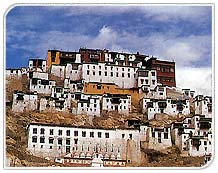Ladakh Travel Guide
---------------------------------------------------------------------------------------------------------------------------------------------------------------------------------------------------------------------------------
Ladakh Home » About Ladakh Travel Guide » Religion & Culture » Historical Background » Ancient Routes » Modern Routes
Central Ladakh » Fairs & Festivals » Oracles & Astrologers » Arts & Crafts » Cultural Tourism » Archery & Polo » Adventure in Ladakh
The New Areas » Tourist Information » Air Line Ticketing » Car Coach Rentals In Ladakh
Travel Agents & Tour Operators in Ladakh » Hotels & Resorts in Ladakh » Map »Travellers Tools
---------------------------------------------------------------------------------------------------------------------------------------------------------------------------------------------------------------------------------
Ladakh Home » About Ladakh Travel Guide » Religion & Culture » Historical Background » Ancient Routes » Modern Routes
Central Ladakh » Fairs & Festivals » Oracles & Astrologers » Arts & Crafts » Cultural Tourism » Archery & Polo » Adventure in Ladakh
The New Areas » Tourist Information » Air Line Ticketing » Car Coach Rentals In Ladakh
Travel Agents & Tour Operators in Ladakh » Hotels & Resorts in Ladakh » Map »Travellers Tools
---------------------------------------------------------------------------------------------------------------------------------------------------------------------------------------------------------------------------------
Historical Background
 For
close on 900 years from the middle of the 10th century, Ladakh was an independent
kingdom , its dynasties descending from the king of old Tibet. Its political
fortunes ebbed and flowed over the centuries, and the kingdom, was at its
greatest in the early 17th century under the famous king Sengge Namgyal, whose
rule extended across Spiti and western Tibet up to the Mayumla beyond the
sacred sites of Mount Kailash and Lake Mansarovar.
For
close on 900 years from the middle of the 10th century, Ladakh was an independent
kingdom , its dynasties descending from the king of old Tibet. Its political
fortunes ebbed and flowed over the centuries, and the kingdom, was at its
greatest in the early 17th century under the famous king Sengge Namgyal, whose
rule extended across Spiti and western Tibet up to the Mayumla beyond the
sacred sites of Mount Kailash and Lake Mansarovar. And gradually, perhaps partly due to the fact that it was politically stable, in contrast to the lawless tribes further west, Ladakh became recognized as the best trade route between the Pubjab and Central Asia. For centuries it was travered by caravans carrying textiles and spices, raw silk and carpets, dyestuffs and narcotics. Heedless of the land's rugged terrain and apparent remoteness, merchants entrusted their goods to relays o fpony transporters who took about two months to carry them from Amritsar to the Central Asian towns of Yarkand and Knotan. On this long route, Leh was the half-way house, and developed into a bustling entreport, it bazaars thronged with merchants from far countries.
The famous pashm (better known as cashmere) also came down from the high-altitude plateaux of eastern Ladakh and western Tibet where it was produced, thorough Leh to Srinagar, where skilled artisans transformed it from a matted oily mass of goat's underfleece into shawls known the world over for their softness and warmth. Ironically, it was this lucrative trade, that finally spelt the doom of the independent kingdom. It attracted the covetous gaze of Gulab Singh, the ruler of Jammu in the early 19th century, and in 1834, he sent his general Zorawar Singh to invade Ladakh. Ther followed a decade of war and turmoul, which ended with the emergence of the British as the paramount power in north India. Ladakh, together with the neighbouring province of Baltistan, was incorporated into the newly created State of Jammu & Kashmir. Just over a century later, this union was disturbed by the partition of India, Baltistan becoming part of Pakistan, while Ladakh remained in India as part of the State of Jammu & Kashmir.
Ladakh Home »
About Ladakh Travel
Guide » Religion
& Culture » Historical
Background » Ancient
Routes » Modern
Routes
Central Ladakh » Fairs & Festivals » Oracles & Astrologers » Arts & Crafts » Cultural Tourism » Archery & Polo » Adventure in Ladakh
The New Areas » Tourist Information » Air Line Ticketing » Car Coach Rentals In Ladakh
Travel Agents & Tour Operators in Ladakh » Hotels & Resorts in Ladakh » Map »Travellers Tools
Central Ladakh » Fairs & Festivals » Oracles & Astrologers » Arts & Crafts » Cultural Tourism » Archery & Polo » Adventure in Ladakh
The New Areas » Tourist Information » Air Line Ticketing » Car Coach Rentals In Ladakh
Travel Agents & Tour Operators in Ladakh » Hotels & Resorts in Ladakh » Map »Travellers Tools